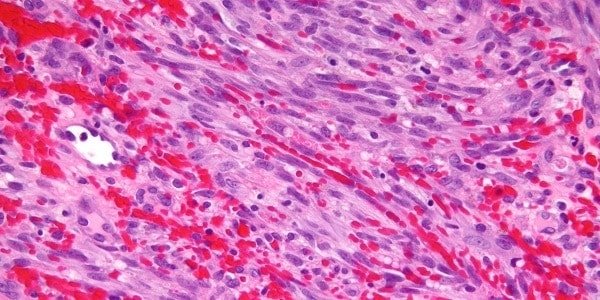Kaposi’s sarcoma

Kaposi’s sarcoma got its name from the Hungarian dermatologist who first described the disease in 1872.
The prevalence of the disease is not so great, but among HIV patients, it reaches 60-80%. In these patients, sarcoma is the most common malignant entity.
According to the data of a clinical study conducted in men, the disease is diagnosed about 8 times more often in men than in women.
The risk groups in which the development of sarcoma is most likely are: HIV-infected men, elderly Mediterranean males, Central African ethnic groups, organ transplant recipients or patients on long-term immunosuppressive therapy.
What are the symptoms?
Most often, the disease begins with the appearance of violet-blue spots on the skin, in which rounded discs form.
In some cases, sarcoma begins with the appearance of papules on the skin that look like flat lichen. The nodes gradually grow, reaching the size of a walnut or walnut.
They have a dense, elastic consistency and a scaly surface, and in most cases veins are also visible. The nodes cause pain to the patient, which increases when pressure is applied to them.
Over time, spontaneous nodule resorption is possible, forming scars in the form of a hyperpigmented depression.
There are 4 clinical variants of sarcoma – classic, epidemic, endemic immunosuppressive.
The classical form is widespread in the countries of Central and Eastern Europe. Its typical localization is the lateral surface of the knees, hands and feet.
It is characterized by a clear outline and symmetry of the tumor lesions, absence of subjective symptoms, and only in some cases patients may feel burning and itching.
In this form, mucosal lesions are rarely observed. There are 3 clinical stages of the disease: spotted, papular and tumorous.
What are the causes?
Medical science still does not know the reasons for the development of the disease and its pathogenesis.
It often develops against the background of other malignant diseases: mycosis fungoides, Hodgkin’s disease, lymphosarcoma, multiple myeloma.
The last 5 confirm the connection of the clinical condition with the presence in the body of specific antibodies formed during infection with the herpes virus type 8.
Infection with the virus can take place sexually, through blood or saliva.
To date, scientists have been able to identify cytokines that have a stimulating effect on cellular structures in the disease.
These include FGF – fibroblast growth factor, IL-6 – interleukin 6, TGFβ – transforming growth factor. In the occurrence of tumors in people with AIDS, greater importance is attached to oncostatin.
The disease is not quite an ordinary malignant disease.
Weak mitotic activity, dependence of the process on the immune status of the patient, multicentric development, the possibility of reversing the development of tumors, the absence of cell atypia and histological detection of signs of inflammation confirm the assumption that in the beginning of its occurrence, Kaposi’s sarcoma is itself a reactive process, and not a true sarcoma.
Treatment of Kaposi’s sarcoma
Interferons α-2a, α-2b and β are successfully used in the treatment of classical and epidemic forms.
They inhibit the proliferation of fibroblasts and are able to induce apoptosis of cancer cells.
Local treatment of sarcoma includes cryotherapy, injection of chemotherapeutic preparations and interferon into the tumor, administration of dinitrochlorobenzene and prospidin in the form of ointments.



